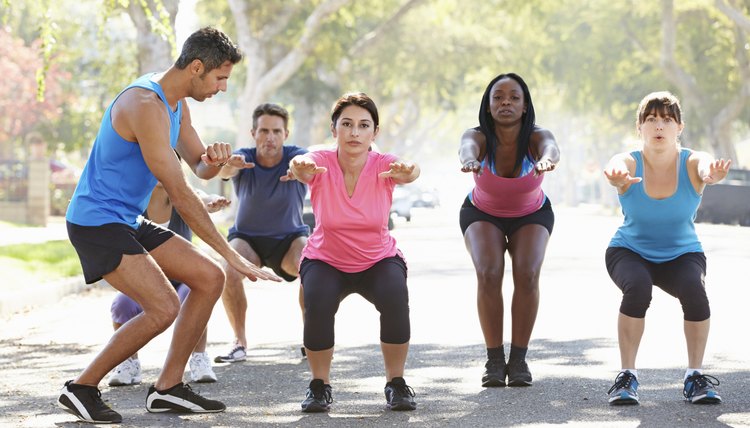What does fact checked mean?
At SportsRec, we strive to deliver objective content that is accurate and up-to-date. Our team periodically reviews articles in order to ensure content quality. The sources cited below consist of evidence from peer-reviewed journals, prominent medical organizations, academic associations, and government data.
The information contained on this site is for informational purposes only, and should not be used as a substitute for the advice of a professional health care provider. Please check with the appropriate physician regarding health questions and concerns. Although we strive to deliver accurate and up-to-date information, no guarantee to that effect is made.
How to Do Tabata Squats

Tabata squats use a fast-paced, intense, time-measured routine that combines regular squats with the Tabata interval technique to strengthen your lower body. Tabata is an interval workout technique that has you exercise at a high intensity for 20 seconds and then rest for 10 seconds. This cycle repeats eight times for a four-minute session during which you should feel your muscles burn. Not only can you improve the strength of your quadriceps, glutes and hamstrings with Tabata squats, but you can also enhance your cardiovascular fitness since your heart rate elevates during the workout. Plus, Tabata squats burn approximately 15 calories per minute, according to the American Council on Exercise, which can help you reach weight-loss or weight-maintenance goals.
Warm up your legs with approximately 10 minutes of low-intensity exercise such as walking, pedaling a stationary bike or marching in place.
Practice regular squat form before you perform squats with Tabata intervals. Stand with your feet spaced hip-distance apart. Align your feet parallel with each other with your toes facing forward. Evenly support your weight throughout your heels and the balls of your feet. Tighten your abdominals by pulling your navel toward your spine to maintain a straight-backed posture. Extend your arms out in front of you at shoulder height. Bend your knees and lower your hips behind you until your thighs are parallel with the floor. Keep your knees in line with your heels without allowing your knees to move forward beyond your toes. Straighten your legs as you lower your arms and return to the starting position. Gently push your hips forward and squeeze your buttocks at the top of the squat movement.
Perform regular squats with the same form you practiced but with a faster pace in the Tabata interval style. Place a clock with a second hand within sight, hold a stop-watch in your hand or a wear a watch on your wrist to time the work and rest intervals. Squat quickly but with good form and move through a full range of motion. Squat as many times as you can within 20 seconds. Use the arm swing -- as you practiced -- by lifting your arms when you squat and lowering them as you stand to help increase the pace of your movements.
Stop the squats and rest for 10 seconds. Remain still or slowly shake out your legs or walk in place.
Repeat as many squats as possible within 20 seconds. Keep the pace of your first Tabata cycle, aiming to complete the same number of squats. Rest for 10 seconds.
Complete eight total cycles of squatting for 20 seconds and resting for 10 seconds for an entire Tabata interval workout.
Count the number of squats in each cycle and aim to maintain the same number throughout all eight cycles.
Modify the number of Tabata cycles according to your fitness level. For example, perform four sets of Tabata squat intervals instead of eight, if needed, until your strength and endurance improve.
Add Tabata squats to your workout routine two or three days a week, but allow for 48 to 72 hours of rest in between sessions. Perform the squats on days you typically do leg workouts such as squats, lunges, leg presses or leg extensions. Substitute traditional squats with Tabata squats for workout variety or add Tabata squats into your training routine for an additional challenge.
Tips
If you are new to squats or have a pre-existing knee or hip injury, limit your squat range of motion. Do not lower your hips until your thighs are parallel with the floor. Instead, bend your knees to approximately a 45-degree angle and lower your hips slightly behind you.
References
- ExRx.net: Squat
- American Council on Exercise: Pro Source: Is Tabata All It's Cracked Up To Be?
- Tabata I, Nishimura K, Kouzaki M, et al. "Effects of moderate-intensity endurance and high-intensity intermittent training on anaerobic capacity and VO2max." Med Sci Sports Exerc. 1996 Oct;28(10):1327-30.
- Trapp EG, Chisholm DJ, Freund J, et al. The effects of high-intensity intermittent exercise training on fat loss and fasting insulin levels of young women. Int J Obes (Lond). 2008 Apr;32(4):684-91.
Tips
- If you are new to squats or have a pre-existing knee or hip injury, limit your squat range of motion. Do not lower your hips until your thighs are parallel with the floor. Instead, bend your knees to approximately a 45-degree angle and lower your hips slightly behind you.
Writer Bio
A mother of two and passionate fitness presenter, Lisa M. Wolfe had her first fitness article published in 2001. She is the author of six fitness books and holds an Associate of Arts in exercise science from Oakland Community College. When not writing, Wolfe is hula-hooping, kayaking, walking or cycling.
